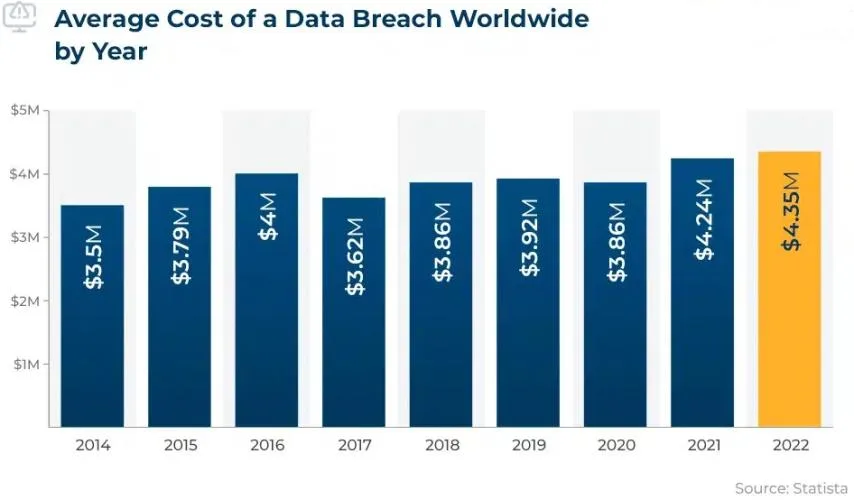How to prevent data loss? According to studies 62% of people who own a computer have lost data at some point, while 76% have deleted something unintentionally. Accidental deletion, hardware failure, malware attacks, or other unforeseen circumstances can be devastating for any business so knowing how to protect your computer from data loss is essential.
Data loss incidents have become a growing concern in the digital age, with computers being vulnerable to various risks that can result in the loss of critical data.
From accidental deletion to hardware failures, malware attacks, and natural disasters, computer data loss can have severe consequences for individuals, businesses, and organisations. Recent trends indicate that data loss incidents are on the rise, underscoring the need for robust data security measures to safeguard against potential losses.
Primary Causes of Computer Data Loss
- One of the primary causes of data loss is accidental deletion, which can occur due to human error or software glitches. In some cases, data may be deleted permanently, leaving no possibility for recovery.
- Hardware failures, such as hard drive crashes or power surges, can also result in data loss, making it crucial to have backup measures in place to protect against such incidents.
- Cybersecurity threats, including malware attacks, ransomware, and phishing attacks, pose significant risks to data security, with hackers gaining unauthorised access to systems and stealing or encrypting data for nefarious purposes.
Businesses and Organisations
Businesses and organisations, in particular, are at high risk of data loss, given the sensitive and confidential information they handle, including customer data, financial records, and intellectual property. In addition to financial losses, data breaches can also result in legal liabilities, regulatory fines, and reputational damage, leading to long-term consequences.
Mitigating The Risks of Data Loss
To mitigate the risks of data loss, experts recommend implementing robust data security measures.
These measures include regular data backups to multiple locations, strong and unique passwords, up-to-date software and security patches, firewalls, antivirus and anti-malware software, employee training on cybersecurity best practices, and proper physical security protocols.
It is also essential to have a comprehensive incident response plan in place to promptly and effectively respond to data loss incidents.
Raising awareness about the importance of data security
Raising awareness about the importance of data security and promoting a culture of data protection among individuals, businesses, and organisations is crucial. This includes educating users about common data loss risks, best practices for data protection, and the need for regular data backups and security updates.
What are the 3 types of data loss prevention?
Behold, the formidable shield against the looming threat of data loss! Three mighty guardians stand vigilant in the realm of data security:
- Network DLP
- Endpoint DLP, and
- Cloud DLP.
These valiant warriors wield a potent arsenal of processes, procedures, and tools, sworn to prevent the loss, misuse, or unauthorised access of sacred information.
With unwavering resolve, they stand as bulwarks against the shadows of cyber threats, protecting the kingdom of data with unwavering vigilance.
For the realm of data is vast and treacherous, and only through the relentless vigilance of these three stalwart defenders can its integrity be preserved. May their watchful gaze never falter, for the consequences of data loss are dire, and the stakes are nothing short of catastrophic!
How Often Do Companies Lose Data?
The harsh reality of the digital age is that no one is safe from the devastating blow of data loss. A flick of a finger, a misplaced click, and suddenly, your precious files are gone.
It’s a nightmare that haunts every computer owner, leaving them feeling helpless and desperate. But what if I told you that the statistics are even more chilling than you ever imagined?
According to recent studies, a staggering 62% of computer owners have fallen victim to data loss at some point in their lives. It’s a heart-wrenching experience that can shatter your world in an instant.
All those memories, documents, and hard work, vanished into the digital abyss. The pain is indescribable, as you desperately try to salvage what’s left, only to come to terms with the harsh reality that it’s all gone.
But that’s not even the worst part. Brace yourself for this gut-wrenching truth: 76% of data loss incidents occur due to unintentional deletions. Yes, you read that right. A simple slip of the finger, a moment of carelessness, and your files can be wiped out forever.
Cyber Threats & Data Loss
Leading Australian managed services company Inspired IT says business’s critical information isn’t as safe as you would hope online. Often, small to medium-sized business owners don’t realise they are vulnerable to a cybersecurity threat until after their system has been affected -and by this point, it’s too late.
“Cyber threats not only put your business, staff and clients at risk, but they also put your family and personal data at risk too,”
“Don’t risk making cyber security an afterthought for your business. Instead, be proactive and get protected Cyber Security services from an IT specialist,” it said.
In a dramatic turn of events, cyber-attacks have now taken over as the top culprit for data loss, surpassing hardware failure and human error.
It’s hard to believe that just six years ago, cyber-attacks and internal breaches made up a mere 13% of data loss incidents. However, in recent years, we have witnessed a stark transformation, as malicious attacks have risen to become the most significant and alarming threat to organisations’ valuable data.
The landscape of data loss has shifted dramatically, and the impact of cyber-attacks cannot be underestimated. It’s a wake-up call for organisations to prioritise cybersecurity measures and be vigilant in safeguarding their data against this ever-growing menace.
While it’s true that more companies are implementing data retention policies, a closer look at the data reveals a significant disparity between large and small organisations. In particular, the Banking & Finance sector emerged as the leader in having up-to-date Business Continuity Plans, with an impressive 61% compliance rate.
Despite the positive trend of increased preparedness, there are still variations across different industries and organisation sizes. In terms of mitigating ransomware attacks, organizations are using various methods to detect and prevent such threats.
Network monitoring and the use of honey pots are among the most common techniques employed, with 36% and 25% adoption rates, respectively. These measures aim to detect ransomware before it can cause any lasting damage, indicating a proactive approach to cybersecurity.
It’s evident that organisations are taking steps to bolster their defenses against ransomware attacks, but there are differences in preparedness levels.
While larger organizations seem to be more proactive in implementing Business Continuity Plans and utilising advanced detection methods, smaller organisations may need to catch up to ensure they are adequately protected against data loss caused by ransomware attacks.
The year 2022 witnessed an alarming milestone in the world of data breaches, with the average cost of a data breach soaring to a record-breaking $4.35 million, as revealed in the 2022 Cost of a Data Breach Report by IBM and the Ponemon Institute.

10 Steps to Protect your Computer from Data Loss
The threat of data loss is ever-present, and the consequences can be devastating. However, fear not, for in this epic battle, you can take proactive steps to fortify your computer and shield it from harm. Unveil the essential steps to safeguard your computer from data loss!
- Step 1: Raise Your Shields with Regular Backups
The first line of defense in protecting your computer from data loss is to create regular backups of all your important data. Treat your data like a prized possession and back it up to multiple locations.
You can use external hard drives, cloud storage, or network-attached storage (NAS) devices to store your backups. Set up automatic backups, so your data is safeguarded without fail. In the event of data loss due to hardware failure, malware, or accidental deletion, having a recent backup will be your saving grace, allowing you to restore your precious data and continue the fight.
- Step 2: Armor Up with Reliable Antivirus and Firewall
The battlefield of cyberspace is rife with dangers, and protecting your computer from malware, viruses, and hackers is paramount. Arm yourself with reputable antivirus software and keep it updated to guard against the latest threats. Additionally, set up a strong firewall to serve as a barrier against unauthorised access to your computer.
Regularly scan your system for any malicious software and take swift action to eradicate them. Remember, a vigilant and fortified defense is crucial in keeping your computer’s data safe from intruders.
- Step 3: Strengthen Your Passwords
In the world of data protection, a weak password is a chink in your armor. Strengthen your passwords by using a combination of uppercase and lowercase letters, numbers, and special characters.
Avoid using common passwords or easily guessable information such as your birthdate or pet’s name. Use a different password for each account and change them regularly.
You can also consider using a password manager to securely store and generate complex passwords, eliminating the risk of weak passwords compromising your data’s safety.
- Step 4: Practice Safe Surfing and Email Hygiene
The internet is a vast wilderness, teeming with potential threats. Be cautious when surfing the web and avoid clicking on suspicious links, downloading unknown files, or visiting sketchy websites.
Exercise caution with email attachments and avoid opening those from unknown or suspicious sources. Phishing attacks are common, so be wary of emails that ask for your personal information or financial details.
Always verify the authenticity of emails and websites before providing any sensitive information. Safe surfing and email hygiene are vital in preventing data loss caused by online threats.
- Step 5: Update Your Software and Operating System
The battle against data loss is ongoing, and software updates and patches are crucial weapons in this fight. Keep your operating system, antivirus software, web browsers, and other software up-to-date with the latest security patches.
These updates often include fixes for known vulnerabilities that could be exploited by hackers. Ignoring updates leaves your computer vulnerable to known threats, so make it a habit to regularly update your software to stay ahead in the battle for data protection.
- Step 6: Backup Your Data Regularly
One of the best solutions you can do is to back up your data regularly. Always ensure to keep a few several backups in case something happens in one of your copies. Fortunately, there are other ways that you can back up your data. Doing so includes uploading your important data and information to your Google Drive or any other cloud-based storage.
Cloud storage allows you to store your files on the internet through a cloud provider. You can access it through the public internet or a password-protected private network. However, suppose you’re unfamiliar with this type of process.
- Step 7: Keep Your Computer Safe From Power Surges
Announced power outages or power surges can be a threat to your computer hardware. Your computer hardware is responsible for major functions, such as storage, input, output, etc.; the subsequent power spike can wreck your hardware. It can overload your computer with electrical energy and fry some components.
Since incidents like this can be inevitable, your best solution would be to install circuit breakers to help you protect your computer from a power surge or other surge protectors to protect your computer from the frequent burst of energy. Also, unplugging your computer after a power outage can help.
In case of power outages, investing in an uninterruptible power supply (UPS) that protects your computer from shutting down during brownouts or surprise power outages is also best. The UPS allows your computer to run for a few minutes, just enough time to save your work and turn your computer off properly.
- Step 8: Keep Food and Beverages Away From the Computer
Electronics, in general, don’t go well with food and beverage. Any spillage can easily put your computer at risk of a short circuit, where the liquid or food crumbs seep into the device. It would be a disaster for you and your data when this happens.
The best solution is to remember not to bring food and beverages near the computer, or separate your snack area and working area.
Prepare a designated place and encourage yourself or your employees to take regular breaks to stand up for a coffee or a snack. This is so that it reduces the likelihood of them bringing anything near the computer.
- Step 9: Keep the Computer in a Safe, Dust-Free Place
You can also lose all your data if you don’t properly care for the computer. Letting it collect dust as you continue your day can put your computer at risk of getting damaged.
Building up dust can cause overheating. On top of that, if you’ve put your computer in a very humid room, you should expect some rusting in the system. As you may have expected, all of these cause damage to your data, as well. This results in data loss and significant hardware destruction.
That’s why you must regularly clean your computer, especially its motherboard. However, you must be extremely careful because it contains important computer parts. So, if you don’t know how to clean them properly, it’s best to contact a company or a person that can help you do this.
Also, it would help if you place your computer in areas where it’s safe, dry, and dust-free so that dust doesn’t accumulate fast.
- Step 10: Be Mindful of Physical Security
Physical security is often overlooked but is equally important in protecting your computer from data loss. Keep your computer in a secure location, lock your screen when you step away, and use a privacy screen to prevent others from snooping or deleting your sensitive information.
Weighing Onsite vs. Offsite Backups to Prevent Data Loss
One key decision businesses need to make is whether to use onsite or offsite backups to secure against data loss. This choice requires careful consideration of various factors, including data security, accessibility, cost, and recovery time.
Onsite backups refer to the practice of creating and storing data backups within the same physical location as the original data. This can involve using physical backup devices such as external hard drives, tape drives, or network-attached storage (NAS) devices, which are kept onsite at the business premises.
On the other hand, offsite backups involve storing data backups in a remote location, typically offsite from the original data location. This can be achieved through cloud-based backup services or by physically storing backup devices in a different geographic location, such as a secondary office or a secure data center.
- Pros and Cons
There are pros and cons to both onsite and offsite backups, and businesses need to carefully weigh their options based on their specific needs and risk tolerance.
Onsite backups offer the advantage of quick and easy access to data, as the backups are stored locally and can be readily retrieved when needed. Additionally, businesses have more control over their data, as it is stored within their own premises, reducing concerns about data security and compliance.
Onsite backups may also be more cost-effective for small businesses with limited budgets, as they do not require ongoing subscription fees associated with cloud-based backup services.
Onsite backups also come with potential drawbacks. For instance, they are susceptible to risks such as theft, fire, floods, and other physical disasters that can result in data loss.
Additionally, if backups are not properly managed or regularly tested, there may be a risk of data corruption or loss of backups due to hardware failures or software glitches. Furthermore, onsite backups may not be easily accessible in the event of a widespread disaster that affects the entire location or region.
In contrast, offsite backups offer the advantage of data redundancy and geographic separation, providing an extra layer of protection against physical disasters and theft.
Cloud-based backup services, in particular, offer the convenience of automatic and continuous backups, eliminating the need for manual backup management.
Additionally, offsite backups allow for remote access to data, which can be crucial in case of a business disruption or when employees need to access data from different locations.
- 93% of Small Businesses Store Data or Backups in the Cloud
The High Global Cost of Data Loss For Businesses
Data loss is a growing concern for businesses worldwide, with significant financial implications.
According to a study by Verizon businesses of all sizes and industries are vulnerable to data loss, and the consequences can be severe, ranging from financial losses to reputational damage and legal repercussions.
On average, small instances of data loss (fewer than 100 files) cost businesses between $18,000 to $35,000, while large-scale incidents can cost up to $15.6 million.
Businesses of all sizes and industries are vulnerable to data loss, and the consequences can be severe, ranging from financial losses to reputational damage and legal repercussions.
The financial impact of data loss is multi-faceted. Businesses may incur direct costs associated with data recovery efforts, such as hiring IT experts, investing in data recovery tools, and restoring data from backups.
Additionally, there may be indirect costs, such as loss of revenue due to downtime, disrupted operations, missed business opportunities, and damage to customer trust and loyalty.
Legal and regulatory fines, penalties, and lawsuits can also result from data breaches or loss, further adding to the financial burden.
Reputational Damage Caused by Data Loss
The reputational damage caused by data loss can have long-lasting consequences for businesses. Losing customer data or experiencing data breaches can result in loss of trust, brand damage, and negative publicity. This can lead to customer churn, decreased customer acquisition, and damage to the overall brand image, which can be difficult and costly to repair.
Rebuilding customer trust and brand reputation can take years of concerted efforts and investment, making data protection a critical business priority.
The global cost of data loss also extends beyond individual businesses to the broader economy. As businesses suffer financial losses and reputational damage due to data loss, it can impact economic growth, job security, and investor confidence.
Furthermore, data loss can result in intellectual property theft, compromising innovation and competitiveness in the global marketplace. The ripple effects of data loss can be far-reaching and have a detrimental impact on businesses, industries, and economies at large.
The global cost of data loss is substantial and continues to rise as businesses increasingly rely on data for their operations and decision making. The financial, reputational, and broader economic implications of data loss underscore the need for businesses to prioritize data protection as a fundamental aspect of their operations.
Proactive measures to prevent data loss such as protecting computer & server data, coupled with robust data backup and recovery strategies, are essential to safeguard businesses against the devastating consequences of data loss in today’s digital landscape.
Data Loss Statistics – 2023
Data loss is a universal risk, and being proactive is crucial. Have you ever wondered how frequently data is truly lost and which types of data are most vulnerable? Brace yourself for these alarming statistics on data loss, which shed light on these questions and offer valuable tips to safeguard your data.
- 96% of workstations are not being backed up properly. (Uni Trends)
- Almost 70% of small businesses close within a year of a large data loss. (Consoltech)
- 33% of all folders in an average company are not protected at all. (Comparitech)
- The global average data breach cost in 2022 was $4.35 million. (Statista)
- 38% of IT professionals worry about mobility/BYOD policies at work. (Storage Craft)
What is Disaster Recovery?
Disaster recovery is a critical aspect of security planning that enables businesses to weather the storm and swiftly recover their infrastructure and systems in the aftermath of a disaster.
With meticulous planning and preparation, a business can restore normal operations by regaining access to essential hardware, applications, and data. This is made possible through the implementation of a comprehensive disaster recovery plan – a strategic framework of policies and procedures to be followed in the face of a disaster.
Disasters can come in various forms, ranging from natural calamities like floods or earthquakes, to man-made incidents such as human errors, device failures, or cyberattacks.
Regardless of the cause, disaster recovery involves anticipating and planning for a multitude of possible scenarios, allowing businesses to minimize downtime and safeguard precious resources including time, money, and customer trust.
By proactively investing in robust disaster recovery measures, businesses can mitigate the impact of unforeseen events and ensure their ability to swiftly bounce back from adversity.
The significance of disaster recovery cannot be overstated, as it serves as a crucial lifeline for businesses to effectively navigate through crises and safeguard their continuity and resilience.
Hard Drive Failure Rates Remain (relatively) Stable
According to Backblaze, a renowned cloud storage and data backup company, has recently released its annual report on hard drive failures for the year 2022.
Despite the growing popularity of solid-state drives (SSDs), hard drives still hold relevance as secondary storage in many settings.
The report, based on the analysis of a staggering 230,921 hard drives, sheds light on the reliability of various models.
Alarming trends have been observed in recent years, with the annualized failure rate for hard drives on the rise. In 2022, the failure rate reached 1.37%, a notable increase attributed to the aging of drives, which tend to be more prone to failure over time.
Unraveling the Mystery: Why Do Hard Drives Crash?
Understanding the reasons behind hard drive crashes can help demystify this seemingly mysterious phenomenon. Here are 5 common reasons why hard drives crash
- Physical Damage: Physical damage is one of the primary culprits behind hard drive crashes. Hard drives consist of delicate components, such as platters, read/write heads, and motors, that can get damaged due to accidents like dropping the computer, liquid spills, or impacts.
- Overheating: Hard drives generate heat during operation, and excessive heat can cause internal components to degrade, leading to hard drive crashes. Poor ventilation, malfunctioning fans, or operating computers in hot environments can contribute to overheating.
- Software Issues: Software-related problems can also trigger hard drive crashes. Corruption of system files, malware or virus attacks, or software failures can disrupt the normal functioning of a hard drive.
- Age and Wear-and-Tear: Hard drives have a finite lifespan and are susceptible to wear-and-tear over time. Frequent usage, heavy workloads, and constant data transfers can put strain on the internal components of the hard drive, causing them to degrade and eventually fail.
- Power Surges or Outages: Power surges or sudden power outages can also be a culprit behind hard drive crashes. Power fluctuations can damage the delicate electronic components of the hard drive, leading to data corruption or physical damage.
Summary – Extended Data Loss Prevention Conclusion
Protecting against data loss is crucial in today’s digital age where our precious files, memories, and critical data are stored on hard drives. Hard drive crashes can occur due to various reasons, including physical damage, overheating, software issues, age and wear-and-tear, and power surges or outages.
Taking preventive measures, such as handling your computer with care, ensuring proper cooling and ventilation, using reliable antivirus software, monitoring the age of your hard drive, and protecting against power-related issues, can significantly reduce the risk of hard drive crashes and safeguard your data.
Remember to back up your important files regularly and consider using cloud storage or external backup solutions as an additional layer of protection. Being proactive and vigilant in protecting your hard drive can help you avoid the distress and loss associated with data loss incidents.
Don’t wait until it’s too late – prioritise data protection and take necessary steps to keep your valuable data safe and prevent data loss







